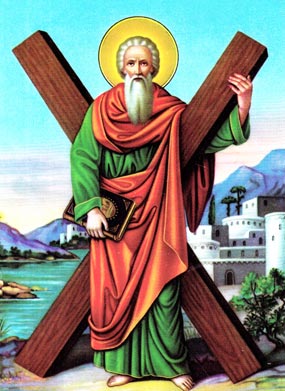
30 November
St. Andrew (1st cent. A.D.)
Apostle
Born: early 1st Century, Bethsaida
Died: mid-late 1st Century, Patras
Major Shrine: Church of St. Andreas at Patras
Patron of: Scotland, Russia, Sicily, Greece, Romania, Amalfi, Luqa (Malta) and Prussia; Army Rangers, mariners, fishermen, fishmongers, rope-makers, singers and performers, fish dealers; fish mongers; fishermen, singers; sore throats; spinsters, unmarried women; women who wish to become mothers.
St. Andrew was a native of Bethsaida in Galilee, a fisherman by trade, and a former disciple of John the Baptist. He was the one who introduced his brother Peter to Jesus, saying, “We have found the Messiah.” Overshadowed henceforth by his brother, Andrew nevertheless appears again in the Gospels as introducing souls to Christ. After Pentecost, Andrew took up the apostolate on a much wider scale, and is said to have been martyred at Patras in southern Greece on a cross which was in the form of an “X”. This type of cross has long been known as “St. Andrew’s cross.”
COLLECT PRAYER
We humbly implore your majesty, O Lord, that, just as the blessed Apostle Andrew was for your Church a preacher and pastor, so he may be for us a constant intercessor before you. Through our Lord Jesus Christ, your Son, who lives and reigns with you in the unity of the Holy Spirit, God, for ever and ever. Amen.
Things to Do:
The feast traditionally marks the end of the Church year and beginning of Advent. Advent always begins on the Sunday closest to November 30, with this day being the last possible day of the old Liturgical Year. Christmas is right around the corner. An old saying reflected this:
St Andrew the King
Three weeks and three days
before Christmas begins.
Because weddings were not allowed during Advent and Christmas and Andrew is the patron of unmarried maidens, many countries have marriage-related superstitions connected to this day. See Patron Saints Index for a few traditions.
Beginning today the Christmas Anticipatory Prayer, also known as the “Novena to St. Andrew” (Hail and Blessed be the hour…) is prayed every day until Christmas.
+ Hail and blessed be the hour and moment in which the Son of God was born of the most pure Virgin Mary, at midnight, in Bethlehem, in piercing cold. In that hour vouchsafe, O my God! to hear my prayer and grant my desires, through the merits of Our Saviour Jesus Christ, and of His blessed Mother. Amen.
- Read Anticipating Christmas, Beginning with the Saint Andrew.
- View some of the art depictions of St. Andrew. Here’s another Gallery of Images of Andrew.
- Remember to pray for fishermen and all who make their livelihood by the sea.
- Andrew is the patron saint of Scotland, Russia, and Romania. The flag of Scotland (and the Union Flag and the arms and Flag of Nova Scotia) feature a saltire (X-shaped cross) in commemoration of the shape of St. Andrew’s cross.
- Read more about St. Andrew from Butler’s Lives of the Saints. Also read about Andrew from The Golden Legend.
Andrew, Peter’s brother, and John were the first disciples to follow the Lord. With tender delicacy the Gospel (John 1:35-42) describes their first meeting with Jesus. Andrew did not belong to the inner circle of the apostles, Peter, James and John, and the evangelists narrate nothing extraordinary about him (John 6:8); but tradition (resting on apocrpyhal Acts) extols his great love of the Cross and of the Savior; and the Church distinguishes him both in the Mass (his name occurs in the Canon and in the Libera since the time of Pope St. Gregory I who had a special devotion to him) and in the Breviary.
The story of his martyrdom rests on the apocryphal Acts which lack historical foundation. The pagan judge exhorted him to sacrifice to the gods. Andrew replied: “I sacrifice daily to almighty God, the one and true God. Not the flesh of oxen and the blood of goats do I offer, but the unspotted Lamb upon the altar. All the faithful partake of His flesh, yet the Lamb remains unharmed and living.” Angered by the reply, Aegeas commanded him to be thrown into prison. With little difficulty the people would have freed him, but Andrew personally calmed the mob and earnestly entreated them to desist, as he was hastening toward an ardently desired crown of martyrdom.
When Andrew was led to the place of martyrdom, on beholding the cross from a distance he cried out: “O good Cross, so long desired and now set up for my longing soul I confident and rejoicing come to you; exultingly receive me, a disciple of Him who hung on you.” Forthwith he was nailed to the cross. For two days he hung there alive, unceasingly proclaiming the doctrine of Christ until he passed on to Him whose likeness in death he had so vehemently desired. –The legendary account of our saint’s martyrdom has this value: it presents to us the mysticism of the Cross of later times.
Excerpted from The Church’s Year of Grace, Pius Parsch.
Source: Catholic Culture